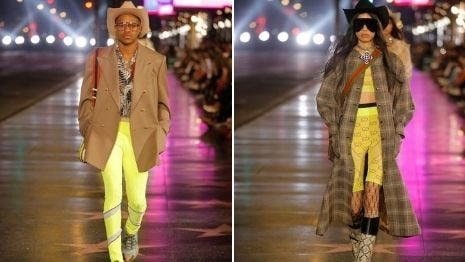Whether attracting consumers to a virtual or in-person event, connection is of the utmost importance.
During a webinar hosted by brand performance cloud platform Launchmetrics on Feb. 17, a Vogue executive discussed the importance of knowing one’s audience and how to connect with them in hosting any event. Although challenges in event hosting in a post-pandemic landscape can permeate, brands must remember the purpose of any kind of event which is to engage, connect and entertain.
“We are always looking at how we can connect [with audiences],” said Jessica Nicholas, director of special events at Vogue, New York. “We all want to be thought of, we all want to be valued and we want to have fun.
“At the end of the day, we are planning parties essentially — we are planning spaces for people to get together,” she said. “Remembering that at its core and how you feel when you go into an event or a virtual landscape is a great place to start.”
Knowing your audience
Whether an event is digital or in-person, challenges may arise. Roadblocks can include an ever-evolving guest list, the complicated process of sending invitations, curating a smooth guest experience and understanding and tracking results.
To start, it is crucial to know what one’s audience is looking for and to invite them to events that reflect these desires.
 Virtual fashion events can make it challenging to connect with audiences, but this is not always the case. Image credit: Launchmetrics
Virtual fashion events can make it challenging to connect with audiences, but this is not always the case. Image credit: Launchmetrics
When inviting consumers to an event, the personalization of correspondence goes a long way. From emails and texts to social media interactions, consumers want to feel seen and valued.
“We are always looking at how can we connect, and we want to make sure that that personalization, when we're sending out an email, we want you to know that it's us and that it feels like you're talking to a friend, essentially,” Ms. Nicholas said.
Brands should also continue revisiting what has worked and not worked in previous events, utilizing digital platforms like Launchmetrics, observing research, KPIs and consumer feedback.
Ms. Nicholas also noted that at the onset of the COVID-19 pandemic, she would watch late-night television shows to see how hosts were interviewing guests and promoting digital entertainment.
Many luxury brands are sharing more behind-the-scenes footage of fashion shows
Organizations also need to keep their eyes on what events and collaborations are occurring in the fashion sphere, digitally and at physical locations.
To learn what works, curiosity and agility are crucial. Brands must continue looking back on what is effective and adapting to what could work for the future.
Physical, digital landscape
Although it is impossible to predict the future and whether digital or in-person events will take reign, or hybrid events will continue, it is clear brands must know their audience, promote enticing speakers and event topics.
When contemplating virtual events, brands can tap into a world of new technological offerings, from straying into the metaverse, offering VR or AI features or liveshopping events.
Artificial intelligence started popping up in different areas over the past few years, with pop-up immersive experiences and virtual try-on technology. Now, these technologies are beginning to form what could be considered a digital renaissance: the metaverse.
There are still mixed feelings about the metaverse, from both brands and consumers, but the more fashion brands leverage virtual technology, including gaming, the closer they become to creating new strategies for the metaverse (see story).
Physical events like runway shows are still beloved by many consumers as well.
Last November, Gucci put on the ultimate parade celebrating love, complete with a star-studded cast and guest list.
Gucci showcased a wide cast of musicians, Oscar-winning actors and more on Hollywood Boulevard in "Love Parade," highlighting more than 100 looks. The event held seats for 500 guests in a celebration joining Hollywood and Gucci ethos (see story).
“I think for us, it is really the talent and our content that we're putting in — that usually is our biggest draw,” Ms. Nicholas said. “Doing some of that research —what do people want to know about?
“Whether it's a controversial topic that we're attacking head-on [or another kind of event,] I think it's really understanding who your consumer is and what they want to listen to,” she said. “And then adjusting your programming to kind of fit into that need.”
{"ct":"Ai6CNyd7igno7uYrxlcJLojKrDNz4REI0ZqreGoQwyFmc4QwAmIlpHd7qdIXtgyflTl8z5IeWu5uPZkcNPFS9hBg8X1S2apKDcP2n\/I1AFKKxrHn7mOwatK8b8QCv98ovKvuJubDOIDySwO57xs3zHOLw2QaxJSwiv44rvfhJUyJL1jzfYMEvpMxuF9Jof3uX+X+Pn8vPnyk\/Cdkz5+XLYX8o7lasZePXS19qWK3xa3MW85tJsJcUYiHU2oa\/YTjmujOxWrTXeRKZbrKPlp5ZSlncbvF110NpBf8wNKRYTfBwkp+9uxGuPS+HmQcVTVaj0lHZijFguiQffk5ZxRPeRRKHcb3YnXgHz9UBIBzrM7bu0pdGi7kc2O7HFNW1kyZhWdgCRcXadozFHBwdk5ohnhbkc6O373Sgeta2XHW3kJNMxZmgjrn6LdTc0tInps\/41e3Ui75vki2JALg4is98xPHHSDIhBX5kZHM80yS2gsACGFZ0tRQHY+trrqajtPtuuL06CTI38wzEledH9mmWLssM79S9X1JuwOrql01vOm5WZYkjFsNyuXKls9PbYZcSIOk9+0x99aGB5UKInY38vn+WgBu8IVFikjAJXztdhBY5NC0M+ABngAHBAq0L9+JNdt56C2hSw1z4RxYch2O6KRPzrSvbtkIgdz1JX\/TQ4Mlssd2LEjmAyEFV2RDN9tUE36GH\/En4yx+fA616kkbJJUP+nimDkLMaHb2MAPhm73+JGNDDiz2ZTXKqNelufwkxWFgj1muHHKRjt5yKxyLx+Kqnl3Me\/Ir8PAZPKZP14WajUqijkCsZ2N1xsvl2D9jOZjBWLe\/sdmoJohgs\/b0AWaUhay60VNt0LWTDvhjovOQFOnGfFU1afExAfINstirq+KLWeOHjG4mAoKPdA3TEsQZzmIvEwc7DQyP\/d29dnu1GCETcW0FfzTR+F00UGil9hbWIvErH7+fBNwR2vB4GWSl37gk42rcecHFbnCbGlsk4mEO33bK023Cu+48urP0PpPxJvC8IN0MNCREl6irr9stoNNvxOTnVqB0lIlgzNLmACHyKb7Cncn+qEX4qe0IxhiFzJydTWr0hic8V7PgDbfSzo8DUOfnp2rRelBd55M+WoOryhe59y3Wy5+02dLOxfhFjyYofMpbMWJY1sVkTkGsIKEoTKGlTpGgCNBqiaew2e1Zbw6LWCwZoDHJJ5cFXPPxGIrWd\/rkBscD8wxYlsCKlGaJzSfNQpfuc2drxBqoKHQWEkIrUEatHHMk74s0aX7pkY7lOYWagWpr3PvoVcfunIyOMMA2nLxxNoecyq2EsLn0oob70LdwOUOdAZbhYIRFpGcLdkU9Dzw\/8WHoqY03DBaxqRZlCIdg1iOKh9bo8Ugv5zpVFt9IzuiTfbh3QMKZXXHDZqGurwLHeUDbAe4MYfXGtVv1xKUgz\/zND6eb9WoZcTP6iYV01sxV1mY\/\/DwFJ2DSrWDOZETYo1W0A01IJLH9vnxANLvZJXEPWSqco7l1qgoPJsOpBknuIocq1UpxPo9cM5DiluW23VaF8PvDgph2ybtReu63B5awg+wmI8ANdGmpcooIlPp+lbseOXuCZTGvIGGQdPq5CESRSIoA4SRwAW0+32xmLD9it0Gv\/DpKUuF2J4JxEgOlK8+BwZauf868lJwypBZv0YfP4m79zBAGH+PN\/zsVwIV4SYinEXWGndaTpEZhOepBsyayMuV4EpYwRldeYbOenKtVgf0lk6485uhqPX4eg4qphu7jMB+7K1HB4IAmsws4YWzLoN8YITy4T0oxdVbq9BSngzQN9CzeNrPwQizLYHBBRhl26c9A069qaFPjuGXIJSwWVZkWNx9ZjQyObgNrbmQX4MXx87WMNoMHDEYh3kskZTHdZKyyaKu7CBuIL2EEmCsbN34rnjKQrn2KHdLz8E+\/ax9XF29Tr1B80E7Cr7qXwV+6PceafnElYFQSfqMFRT\/gr+fWr0gzzsF4tbwLJj+\/lLBflpSQTA9vn\/bHqLKRfAhCgllB2Hnd9so03UwExkleE3kTl\/YZZD5wm798Mo1xvPOtqwYRIgvGp\/FX3\/pkcKYd3jZMfXyDqEPa4nueOj9S4jLBAvj\/55dbrEIsNnxzHCa8SKxAT9j1e+FkBgs5HorN0dQdhyGE3MAWqOyvws9NDfDAzKZ3L\/A1feY7TPqVtL2msBCliQbG\/k2wOHygI8R9qibMJkF7VNazFqzUDsHO3ZleNnot0+beew9UgYoIyKjm4mTdfUF1418NE6Pj0Xlgaci0bUAMUXEwAUHi9Qzgy4RvoQ4rPFY4XiOdqLqkFr5jOvNqYtoyZr7nNbuHAnJZG2A6Hor6baPIhvolW8x+jIIcrhsAaUZ+MwrXI0HhdO9zYwc4t0P\/cNJJrEV4\/4ZIx3saBUd41ZqSwut0eKJV0064GjhRb5kSNndMDMjzjCEPcGI2z+4aR6LR3Y7nu1VlOfKmNiA5twkzC+h6odvc3iqI+NML8aHR7kZY6K84Hwd6siqTip9qIAgUHqW4g8C6zKNSCWe4HY5PkA+VW785CVSxOwr25uaH4Q32R7zG26fn4J2ahKAuDSUVpyM02Dkq2vMcKkny8kvFilf\/mve9Xy6wqJDUmFRnZaBEabqiDqGyW9zW\/r4KyOnt\/l3xg8yFulRAyLe0xMXeyEJkpm12gHlxbiRd0GoYYEnH65FGDnVJY8TY4qwTEnFYUmP7dhsQmhtyjXrWquubyNs00RlBTbmSUNjwqMx4wX+6PQ5Zn7ErVhNQloEgM50l\/evnKKwvibxE1nSZyNqnfV52VpGyqeUbPvyUut7XhjEfSKNDOIxxQv1UyxSL\/vzbadyDnLbmmPFQ86JqBrX0KwGA3Xl8HqLotLghQw8G9ReafmdTToOln20UW5vQxlpRqtL45QzMjPR35nrM6noAyuV6S7TRsGLZ+gyUksrEdrI7kSJHKXpH5dnulR1jRMcwsHAT4RtINHARjsJtsNuZfVcenlQEssdZ0OUTN+um1fUu7sIhjbsrarwzFnLpUDqWFPA4fAG6OkmMtadPdEz2zq1XVx0+kF0Pm35VgYsn\/Yxp\/ZnPTfbjIJs9UbcQC02BPqFqvPDk2r\/rVbZ\/yK\/yrSXs0jsukhGstsCEDtFtk8N3SfqWOmGWROPRvDUnGq\/Y0sXVoVeeHFnOfNCoIXkFGybkyjJW\/3WMGZmWz9aOKuAVwra0wuxbJmbMSGPFIUqdR+kfdlBMte3nbHZTOU9+lokn3MtddGavtakDZ+Xtd+yfud1GnaTS1YFVCAiHaMBe6B0heUb6A7TcqSfNUnZjg5+3Vnvq2cnAFIs+EFWK9\/UGuaL6MBNZOlOvxfRh3p3MXfGwRtsEIUQ5zsHdjvEChzsSi5GrZuJ2hzRBuTxnhsOAwjrqUc7B0xL4zMhQnL1fG9TJwB825EvWylQUiFUp8yfcKB5eRwEX\/nJsXA2K7A1DqhF7Gbb1QIVLTtmhWUalO08Jmxv0ydZXjNn4YJbx6qqGBoe3bAeAKDRZYKOMPXu5XXEGpGrmoV8r6QezPlEVD6mtFAUlT9cN9bN668OCsnb4oqLXKw0v0G8BhMsuYkFQbhlAhAy\/ZL5LdoskM7bP8K8rzcoQFFNEArGYsCYgYSsdZeUn5op8k2Bp+iCAOCzmPUEBrYzuqZWAayNmcA6U6AGi2cNM8OuJxGLuNttFirMeLdRfcxrU6ZgaYvkQNOv6NFjnbYT6\/TeOlKg50E+gnbILdy3Rbw+50FLPC0il7YdL94EAF0rQ\/9NtOul8zm1BVKz1Lq41teEDvEGI\/QenWoslPXoZrn5L2xBltq1C1uBIj2blkGcmzDg8llYcdQBsFSgpRAzO5vcdnDsQMbH2Ha\/R0rBxJiCOYc0OfmyxuzQCvOdbT2+8vghM8xNVtLVEKCW5yfPUUTtrN4CMVhrjpiRxDrHgKrglDRn7yvBOdVR9X73QtVK4efOmQOH31njFw7SGDO10W4JUimX41X2bU8eZZmwV7OwXKWhKVxUN9DqzuggZ1iCKbZUc8gXl6qXF9maI+StwrtIDvLDV1zUYde\/3WTIt8C9zejkM5hMikGX5jf7Wkk61BfDr1iDtmpLcPLr4GGZIIK07BK1lFB5iYCyuHgmywiGUwkNTaDMASQ+YFM2m1eg6QTrN+FrZVf4MKYirwfhVMzUB\/chDy9SYWl9bqd86MKOJQDVZf60fOFoX076dIZ+isKgf8ZdK7w6Co9f6z\/VPuWzpR+3JMgHDu41bQkl9sTvDM\/aKCaMSd8+Exn+zTCfxFaYtaV1bl7SWKw8axc+4\/qVXycPBnSqjf\/bq0nd74M+ShebiA1osftjS0oM+GD2abn1lLtIdBwdezKUG2JM4igaDMGwvGB81xL284QLS0DJd\/QrT3fvW+bI+2vM0CIYIqjntwdBcSpHG616HwrnnKlIUbeML4czWXQA+rXIREWJMJ+IYd4qXW2H\/OeYM28HpYwaI401ow\/wTA8dRVBQ2LdC8VHb30mcePrgDdB0QMLhVMZgZ8JQIM1D7RuzySZ1Nr+sNJfsF38kCNeAPhmKsvKveUHFryzszDUSoi\/jmLNNmZAB8f3VM2ZQVRLTs\/l82\/hBpSjZ9DenNtAoQ2SyBtFIn4\/oGGFaiqzSF2gaVE1JEs9CQsreTjs3AGLcngrevQdJtwDKZDUbdDrMBksc+Hn9mALNPcygNcK8N9PDWVCuAWH9BmCqBEpBDwX6yLwABA5d6bDMov3YHP5KmCYU8rw6jLh16I0XRZ31KiA4uOvZFszCYstZdo\/bqp+b9v5iPky3uGxZBkR0IRm6uUK\/hMtpOf4sKfpDL6xA7RP2wLFIlsSZvDv3ZTNpOa0uEm2Xreui4p1uZqAUs1Up2rCTnG8NIgNA98onDrhK7OBgG36qE1Fd9yrCAoMMfk+m19aJNsS6Ek\/BB3M5WSi22xgFxw2KUtlA6sv\/KPNnYw85Al1rh9MQ+1Q0gb1TRmcSK7nlocJbqqu4AduY2C01zo3o77LaNRTXGhvfggd6gMHQ1kQDcpj4foyw4xaLVJs80Rt06E0GOqa8ShdlzN+p9GoD8Z521RvmvJtkdsy1G3\/iUwfiShTaXc0ZjF\/a6G4IuGbpT2SlJdzKISStlF3agefP4Vb+FGoH49nj2Z5dS\/g2ZMEXAixBd3qApb981OMy8aH06vZflYDteE76G0Eh5sCzKubX9ZtyUW0+BQgz4PqvdE61nMUncQAuKoME1epGc1cqctLlqDONVj95MGrc9FtKmx9wJqmGkIe3Vsg2o4k6ilOGu7Eu5Nfdv+4znJJkAAHp5kJ45Qes3I4b6wej\/jn0QJtkQH0vfTgaPE7mkFpdoJQkI9\/CpjAbjWapiAniXmmqmyKiw3iOur6KHXlycnEISP5ON+Po8bCn7T00IiusdCukBakJAVQkXn4LdZhvd4yPDk60QhBTC6FHinAE6\/nSDBIh2RUjh2mmeqjuLHG7JZu12Natj6mlLy0u9hnzHxpnY+Ab\/TD+TOK\/puryT9U+u6ejKg5fYyWzt4HdHVk4q1J1Z30Mn+2yddHugrHYmbmBxOjlNlgqBBnrZEJJBHrUDEElUaLRA26EwRrRHzr+AAq71NiQfVVuLfMnHhSsP6PiD5fojTKlsRiaE5Wh5zMAuiKDZgiH97qxxdJIjt9Yu2PFoT50sHW897mgeQ2Lsu4RSLSx1bgGBsGZMCwNEZ+Lucno2lpXghS1LI\/fqFvWI1zcM2\/ntLJKYD1L8hWkNuInn0HV1jGN18C3s2pd8fdIWStE4FipatKTFso+BpJzRsc3iffiiHZy+AEzR9KfWZQkI5TVH8NUjYRd94YDEBlesyVxLgB5OkG2eNLcP9WY\/RHCmuukB9sMYSHJc+eaAjFcApFCjE2V0hfBXvDwDHQHoIHkEktLfysVrEsT8HFFGnP5D65woMZ5xklxoOM6C9xz8PjLZwD6u9qqbQKhSo44qxo9IpkjU8\/WsTSwxYMGmO9u\/qoU0\/3OAgG1KTlI35Ty8qnFX6lVwmagFzh8A6FWyyf71RIo750IbUbeHIrphkwC0YFJyz5CttsNrvL57Yxwv1htAZb9otbHz+xovLLAiQUIR2oFOejnTE+WMO+Sm2Eafk5cl7CaXzJWDUZp9JnUjPDFW+WachldSQKPmt\/M\/cijglfOmDVgkxXfc5xKhYYFiWITPKFT1i5Ls7I2U5AD\/1l7IPjU8gS2vEPNacnN2xbJ9sXUezYI8i5HYZdcffFbQBxQih7545O+0k5fH2DLwMdcJAxPFRbJokxAZP0Hg8LygjNQFeAV\/oSCZO8HS5l+QzLh4Xe3gMQeOKLTEAKWF6WzF\/4dbrKqZSw5ZzNE5VppHfIHOq5t+\/hgwdd72dMt+Qs6U5s7uIdrEdmcUjB7CPg7OLtw8bF4TpkPkYbM6qrFhHZIyjZMsqkjw2BGawhrWorIfqRONpj0j8Pe4JqnwfEqInTxCGhVV54Z0TI3RW3SvzdgkqQrO3gGDtQX4h+LlO6BdqPIDdu2GUES+fTpwi\/CMOGPfkVxwafiEjb9TW49PCrVen8eq8LWeg7hRbfOi0R2r8qQFcBc5IRr5LwN63At5Xm6BPjC2gvkIzS8ff42Fpx81WkK+TCB+A4wGQfF+esSo2lWWOtOY9PF5U7una7lnwoqVA5mVLOjN5yUi9AjxuWVP+sDtx9IlcbZ3X6a\/mlbl0KdoIrvANKV8dY7vZErdaWPezt0Q0pAOa9mDk\/rGl0hQGumIulUKsdDOCzPIRGCWQ+QvpuHmPs6qLNwkTV18Bcydh27bnUY9luqrLHx2mI51yMGJR77bfpZeKrJj\/BSULDBPlcmsl7yK\/i5VPmwp4BdWMV6tDFY0E13miX41tDlphiB3FAuYpLuf9yg\/s719bR88GdHnmrwaixIwa5+5vY4g8t9uRU03RlgYoEx\/l0Z9F+sfN8u0MjRdVd0JSaRPLNON7nYhkywQlL9ocSFJFpbbvnZDKLUyZ04U0BLUV7FSegzbW+Kmi0OLLrm3hTlOuOvnBN0jDXIccLqdhZNaetOp2YmzP8XgpdqUCEUk1cwX6sOokWkl6mQtn\/yBydHUZ7EpABk33vxJAU0nPbdKnUnutRjnEDFaRriERA8TOQCd6Ts1mh6+hZ6ZFT1zcDo11yAs+pusow9XkazI2WnAzNjCbgIXkuN7cK1XGAiOPLT54eX3dvXQfNTs\/rWiPq8RENNs0YJoGziGwM4gWSXO03E5gSs0Zy3TDhL9aIHaibCqyv9Mo5o\/KlpMdA+yDaC3b\/Xwsz5aKZyRT3bdETGerfwVql2DGWPypS3N521HmyWO7T\/EyhnXQSG5E7qQqgBU79c7EsG+c9JtiWsPMOgo28u2T0WlvMYGMEdJW5U5tkhNjJCEqXVV4jDT\/y+FdXXNU4apdAeF9p0CdceoFvgpGq9TsagBMLp9pvuTwNM4Wt5v32FD4EBeSjSgF8K4nN3EfMcvJsiMlhVYQLfzyw3P9RqZtA\/nDLq3Rs40ltQOtUZUjcfFrVlIIlTXUEKTfOaRu\/xV1GeWL9gxewSUbKoBorwB37JUa3LdOhAkkY3gMAsZWdYYhY\/fRirW3nl5mD0mBvqPzrEHU0objWw5isZJ+JP\/CHw7C6wC+O0b5XMfP4aF1dxc5IZrqsZW3d8nPqtvCstz76vt\/lUpKoOKfyPjtgryl9xXVERIdEDRsKBEm+g1TFAiu0p3YUTI8W9VbJvsOJQzozotr2mO7x66rIePDej92160JBdKwYdMUwelkMPtjgqL9EC7xzLrF\/7QPuwhBUEoViPvtL\/oIeZKM8izSFDisf\/m\/2avUGxIHZVLMVpDILO7J2c9N4YrutuUh9TjY1GYxQnW5kkhcJmE9As3xV3r1g+TqjQiFUjl5rIj733R0CES50P9L9NL\/y5+Ub8443VLkLgKIZktBq2IRvluMeThAlZef8jjgU4lhqkN\/UuC03Go\/oAsLk6BxITEh+sDwUV0sRgWb+IB","iv":"2a077b264f7326c4840961c29e3bb06b","s":"07b7704ed9c1b051"}

 The Gucci Love parade runway presentation on Hollywood Boulevard. Image credit: Gucci
The Gucci Love parade runway presentation on Hollywood Boulevard. Image credit: Gucci  Virtual fashion events can make it challenging to connect with audiences, but this is not always the case. Image credit: Launchmetrics
Virtual fashion events can make it challenging to connect with audiences, but this is not always the case. Image credit: Launchmetrics